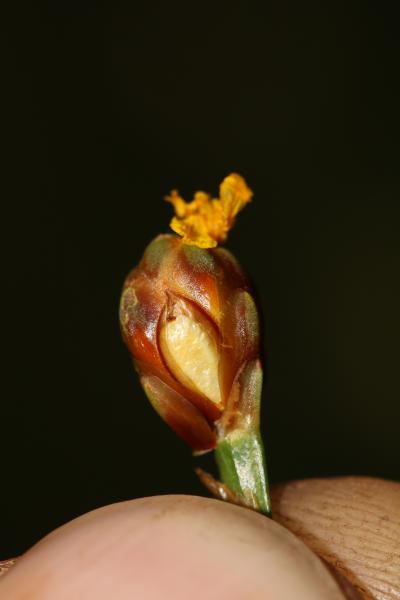
A genus of about 300-325 species, nearly cosmopolitan (most diverse in tropical and subtropical regions, and especially South America). This ‘technical’ genus is known well by only a few botanists, and additional undescribed taxa are possible.
Key adapted from Bridges & Orzell (2003), Godfrey & Wooten (1979), Kral (1966a), and Kral & Moffett (2009).
ID notes:In vegetative condition, Xyris is often confused with other monocots with equitant leaves, such as Iris (Iridaceae), Lachnanthes (Haemodoraceae), and Tofieldia, Triantha, and Pleea (Tofieldiaceae). See Key M1.
Key advice:The most conspicuous (and most often photographed) aspects of Xyris morphology are the showy yellow (or rarely, white) flowers, which are partially exserted from the solitary spike terminating each scape. The emergent flower parts consist of three petal blades, two whorls of 3 alternating stamens and staminodes, and three pistils. Although petal blade size and shape are somewhat diagnostic, the more crucial characters for species identification are of the calyx, capsule, and seeds within the spike (usually concealed by hard bracts of the spike). In addition, the size, color, and shape of the leaves, which are all basal, provide additional characters, particularly the texture and color of the leaf bases, and whether the leaf arrangement is distichous or spirally imbricate. Although the leaves of many species can be slightly twisted, those which are spirally imbricate often have many spiral twists, whereas those which are distichous, equitant or flabellately arranged are typically two-ranked and mostly flat to only slightly twisted. The surface texture of the scape, particularly of the upper few centimeters of the scape immediately below the spike, is often also diagnostic, and can be smooth, winged, scabrous, or many ridged. To facilitate use of this key, and proper identification of Xyris, some of the central bracts of the spike must be peeled back to show the marginal texture of the lateral sepals, which are the two "cat-ear" like appendages surrounding the yellowish, somewhat translucent capsule within, which contains many minute seeds. Whether or not the tips of the lateral sepals can be seen extending beyond their corresponding subtending bracts is also diagnostic, hence "lateral sepals exserted from the subtending bract."
Ref: Anderson & Kral (2008); Bridges & Orzell (1987); Bridges & Orzell (1990); Bridges & Orzell (2003); Bridges & Orzell (2020b) In Weakley et al. (2020); Campbell (2011); Godfrey & Wooten (1979); Kral (1966a); Kral (1978b); Kral (1983b); Kral (1999); Kral (2000a) In Flora of North America Editorial Committee (2000); Kral & Moffett (2009); Kral In Kubitzki (1998b); Malme (1937); Ward (2007b). Show full citations.
Hover over a shape, letter, icon, or arrow on the map for definition or see the legend. Data for arrows not developed for genera and families which may have species only occurring outside the flora area.
 © Gary P. Fleming | Xyris caroliniana | Original Image ⭷
© Gary P. Fleming | Xyris caroliniana | Original Image ⭷ © Scott Ward | Xyris tennesseensis | Original Image ⭷
© Scott Ward | Xyris tennesseensis | Original Image ⭷ © Scott Ward | Xyris fimbriata | Original Image ⭷
© Scott Ward | Xyris fimbriata | Original Image ⭷ © Scott Ward | Xyris platylepis | Original Image ⭷
© Scott Ward | Xyris platylepis | Original Image ⭷ © Keith Bradley | Xyris elliottii | Original Image ⭷
© Keith Bradley | Xyris elliottii | Original Image ⭷ © Bruce A. Sorrie | Xyris platylepis | Original Image ⭷
© Bruce A. Sorrie | Xyris platylepis | Original Image ⭷ © Scott Ward | Xyris fimbriata | Original Image ⭷
© Scott Ward | Xyris fimbriata | Original Image ⭷ © Jay Horn | Xyris stricta source | Original Image ⭷
© Jay Horn | Xyris stricta source | Original Image ⭷ © Jay Horn | Xyris curtissii source | Original Image ⭷
© Jay Horn | Xyris curtissii source | Original Image ⭷ © Jay Horn | Xyris curtissii source | Original Image ⭷
© Jay Horn | Xyris curtissii source | Original Image ⭷ © Jay Horn | Xyris platylepis source | Original Image ⭷
© Jay Horn | Xyris platylepis source | Original Image ⭷ © Scott Ward | Xyris flabelliformis | Original Image ⭷
© Scott Ward | Xyris flabelliformis | Original Image ⭷ © Scott Ward | Xyris flabelliformis | Original Image ⭷
© Scott Ward | Xyris flabelliformis | Original Image ⭷ © Jay Horn | Xyris stenotera source | Original Image ⭷
© Jay Horn | Xyris stenotera source | Original Image ⭷ © Jay Horn | Xyris platylepis source | Original Image ⭷
© Jay Horn | Xyris platylepis source | Original Image ⭷ © Scott Ward | Xyris torta | Original Image ⭷
© Scott Ward | Xyris torta | Original Image ⭷Feedback
See something wrong or missing on about Xyris? Let us know here: (Please include your name and email if at all complicated so we can clarify if needed.)
Cite as...